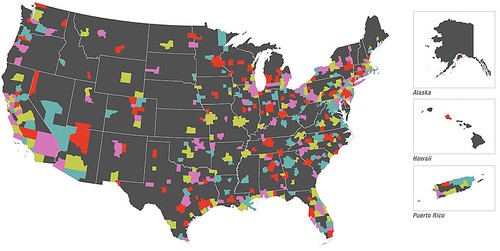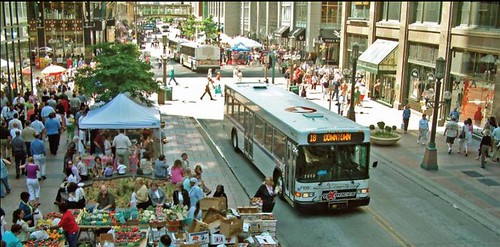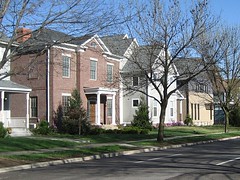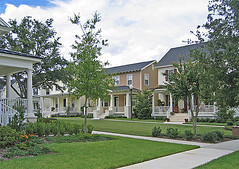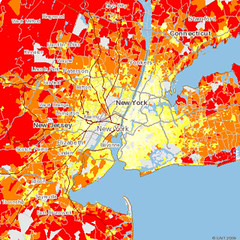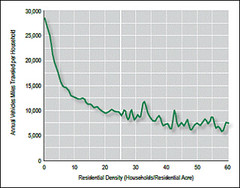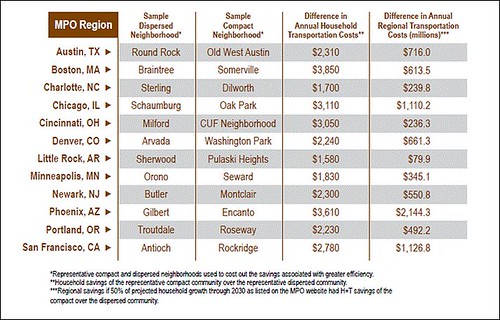Most important analysis of land use you'll see all year: CNT proves benefits of smart growth nationwide

Posted March 24, 2010 at 3:48PM
The Chicago-based Center for Neighborhood Technology today dramatically expanded its “location efficiency” mapping and analysis to 337 metropolitan areas across the country. This impressive resource details the housing and transportation costs associated with specific neighborhoods, along with neighborhood-based, per-capita driving rates and carbon emissions, for each region The work now covers basically every part of the US that is served by a metropolitan planning organization, or 80 percent of our country’s population.
At the same time, the organization released its new report Penny Wise and Pound Fuelish, which may just be the most important document in the field of land use that you’ll read all year. Big-time congratulations to our friends at CNT for making this happen.
(Warning: seriously wonky post coming up. But it's really important, so bear with me.)
As regular readers know, I have long been a fan of CNT’s great work, especially the GIS-based mapping that allows users to see at a glance the environmental and financial impacts of sprawl, and the benefits of smart locations in addressing both. (See, for example, carbon emissions mapping; the effect of location on affordability; in-depth looks at the DC area.) Previously the analysis had been available for 55 metro areas – not bad, but imagine the work that went into the expansion.
CNT’s new report shows that only two in five neighborhoods in American communities are affordable for typical households when their transportation costs are considered along with housing costs.
The Housing + Transportation (H+TSM) Affordability Index covers 161,000 neighborhoods, and provides a comprehensive snapshot of the affordability of each by accounting for combined housing and transportation costs. The more sprawling the neighborhood – the more spread out, the greater its distance from job centers, the less transit availability and fewer conveniences within walking distance – the greater its transportation costs. And in many places the increased transportation expenses wipe out the perceived savings in housing costs per se. (See examples from sample regions in the bar graph above.)
In the organization’s press release, CNT states that, under the traditional definition of housing affordability (30% or less of household income spent on housing), seven out of ten U.S. neighborhoods are considered “affordable” to the typical household. But in almost all metro regions of the country, when the definition of affordability includes both housing and transportation costs—at 45% of income—the number of neighborhoods affordable to households earning the area median income decreases significantly. Nationally, the number of affordable neighborhoods declines to 40 percent, resulting in a net loss of 48,000 neighborhoods with combined housing and transportation costs that stress the average family’s budget.
That's the bad news. The good news, though, is that by encouraging smarter location decisions and smarter development, we can dramatically reduce financial burdens on American families. And, in the process, we can get more vibrant, walkable neighborhoods like these:
As an environmentalist, my favorite part of the CNT work has always been the carbon mapping, which shows that per-household transportation emissions of carbon dioxide rise dramatically as one moves from relatively central locations to more sprawling ones (and, conversely, that emissions fall with smarter, more central and walkable locations). Look, for instance, at the two maps below. On the left is the New York metro area, which has long been available on the CNT site. And as a result of today’s expansion you can now also see the comparable graphic for my home town of Asheville, North Carolina, on the right. In each case (and in just about every other), the farther one goes out into sprawling areas, the more one is likely to be in the red areas of highest carbon footprint, and the closer one gets to the regional center and walkable suburbs, the more one is likely to be in the yellow areas of lower emissions:
At the risk of getting even more wonky, let me offer two graphs below from the Penny Wise report. Note that, on the graph on the left, household transportation costs (red line) increase with increasing commuting distances, offsetting the decrease in housing costs per se (green line), so that combined costs (brown line) rise and then level out. The graph on the right compares neighborhood density with driving rates: generally speaking, the higher the density, the lower the household vehicle miles traveled. I have seen scores of graphs depicting this relationship at various scales, and the shape of the curve is always the same. What I like best about it is that the greatest incremental improvements in performance - the greatest reductions in per-household driving - come at the lower end of the scale, as one moves from large-lot sprawl to moderately sized lots in more compact neighborhoods. We do not need drastic increases in density to achieve a smarter future.
Another chart from the report shows how a sample of compact, well-located neighborhoods save their residents thousands of dollars in annual household expenses. Even more impressively, it shows that, if 50 percent of regional household growth could be fashioned to achieve comparable characteristics to the better locations, the economic savings to their regions over the next 20 years could be in the hundreds of millions and, in some cases, in the trillions of dollars. That is smart growth.
Now that they are so widely available, I’m hoping that neighborhood transportation cost data will soon become part of what potential homebuyers seek routinely in real estate transactions, as is already becoming the case with Walk Score. CNT points out that “it is difficult for consumers and policymakers to estimate the full costs of a location, including the cost of both housing and of transportation. This lack of information can lead families to unknowingly make housing decisions that cause them to live beyond their means as gas prices rise and commutes grow longer. A community’s average transportation costs can range from 12 percent of household income in efficient neighborhoods with walkable streets, access to transit, and a wide variety of stores and services to 32 percent in locations where driving long distances is the only way to reach essential services.”
The data and maps for each region can be sliced and analyzed in about a dozen different and helpful ways at the user's option. And the excellent Penny Wise report concludes with a sophisticated set of policy recommendations, including transportation cost disclosure legislation, realignment of federal funding formulas to reflect true affordability, the creation of incentives for walkable, transit-served communities, and much more. I can go on and on, but you would be better served by going straight to CNT’s site and seeing for yourself. This impressive body of work was funded by the Rockefeller Foundation.
Last updated March 24, 2010, 8:53 pm EDT.
